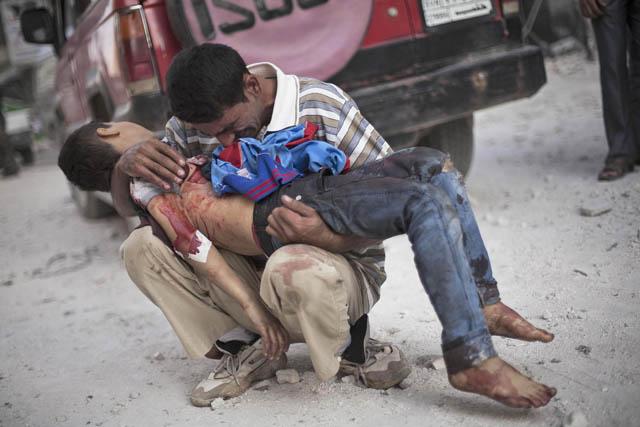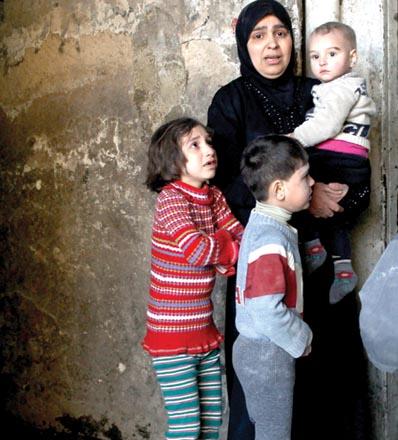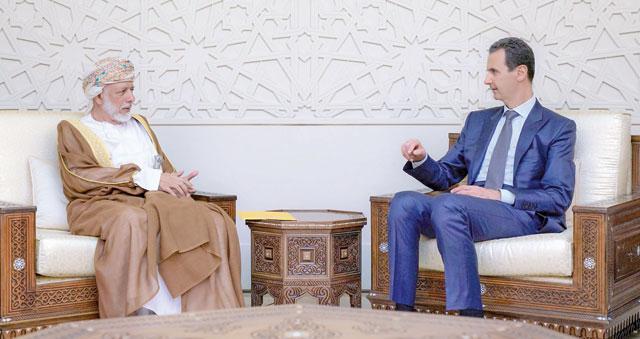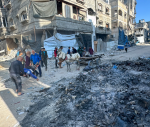BEIRUT — Syria’s conflict was sparked by an act of brutality — the detention and torture of schoolchildren who spray-painted anti-government graffiti in a southern city. In the three years since, the civil war has evolved into one of the most savage conflicts in decades.
The atrocities have been relentless. Protesters gunned down in the streets. An opposition singer whose vocal cords were carved out. Beheadings and mass sectarian killings. Barrels full of explosives dropped from warplanes onto bakeries and homes.
It will be hard enough to find a political solution to Syria’s crisis at an international peace conference convening in Switzerland on Wednesday, given the vast differences between the government of Syrian President Bashar Assad and the opposition. But in a nation drowning in blood, reconciliation and justice over the atrocities seem even more distant.
“The ethical and moral fabric of this society has been stretched to beyond breaking point,” said Amr Al Azm, a US-based Syrian opposition figure and professor at Shawnee State University in Ohio. “For a country to recover from such a traumatic rupture of the very glue that holds it together is not easy.”
In the latest sign of the brutality, three prominent international war-crimes experts said they had received a huge cache of photographs documenting the killing of some 11,000 detainees by Syrian authorities.
David Crane, one of the three experts, told The Associated Press that the cache provides strong evidence for charging Assad and others for crimes against humanity — “but what happens next will be a political and diplomatic decision”.
In the 55,000 digital images, smuggled out by an alleged defector from Syria’s military police, the victims’ bodies showed signs of torture, including ligature marks around the neck and marks of beatings, while others show extreme emaciation suggestive of starvation. The report — which was commissioned by the Qatar government, one of the country’s most deeply involved in the Syrian conflict and a major backer of the opposition — could not be independently confirmed.
“It’s chilling; it’s direct evidence to show systematic killing of civilians,” said Crane, former chief prosecutor of the Special Court for Sierra Leone.
New York-based Human Rights Watch said Tuesday that the United States has focused too strongly on bringing the warring parties into peace talks at the expense of putting “real pressure” on the Assad government to end atrocities and hold to account those responsible. The group also accused Russia and China of shielding their ally Syria from concrete action at the United Nations.
“The mass atrocities being committed in Syria should be a parallel focus of the peace process,” Kenneth Roth, executive director of Human Rights Watch, told reporters in Berlin Tuesday.
For Syria watchers, the descent into the abyss was not inevitable, but the result of conscious decisions by a multitude of players.
“From day one, there was a level of violence used initially by the government in its suppression that was unprecedented,” said Nadim Houry, deputy director of Human Rights Watch’s Middle East and North Africa division. “Since the Balkan wars and Rwanda in the 1990s, we have rarely seen a conflict with that many people killed in such a short amount of time.”
More than 130,000 people have died in Syria’s conflict, and more than a quarter of the population of 23 million now live as refugees, either within Syria or in neighboring countries. Fighters who took up weapons against Assad have turned their guns on each other, trapping ordinary Syrians in the violence of two parallel wars.
Protests started in the southern city of Daraa in March 2011 in response to the arrest and torture of high school students who scrawled anti-government graffiti on the school wall. Security forces responded with brute force, beating and opening fire on largely peaceful protesters, who initially demanded reforms and later moved to seeking Assad’s ouster.
Chilling brutality against opposition figures came quickly in the very first months of the conflict. Hamza al-Khatib, a chubby-faced teenager, was arrested at an anti-government demonstration in April 2011 and not seen again until his mutilated body was delivered to his family weeks later.
Popular cartoonist Ali Farzat was severely beaten up and both his hands broken before being dumped on the side of the road after he compared Assad to Libya’s dictator Moammar Gadhafi.
The body of Ibrahim Qashoush was thrown in the Orontes river with his throat carved out for writing poetry and anti-Assad songs that rallied thousands of protesters.
As opponents increasingly took up arms, the government escalated its repression. Warplanes indiscriminately hit rebel-held residential areas with incendiary bombs and crude explosive-filled barrels, often hitting bread lines at bakeries, schools and makeshift hospitals. Government forces have been blamed for an August chemical weapons attack that killed hundreds.
Sectarianism fueled the viciousness. Syria is a patchwork of religious groups, with Sunnis making up the majority and forming the backbone of the rebellion. Assad is a member of the Alawite sect, an offshoot of Shiite Islam.
A May 2012 assault on Houla — a cluster of Sunni villages surrounded by Alawite towns in central Syria — killed about 100 people, including many children under the age of 10. Gruesome video showed rows of dead children with gaping head wounds in a mosque, and the UN called it a massacre by pro-Assad gunmen. In a massacre blamed on rebels, nearly 200 civilians were killed in pro-regime villages in Latakia province.
Islamic militants and foreign Al Qaida-linked fighters joined the war against Assad — and reports of human rights abuses by the opposition soared, including mass killings of prisoners, beheadings and floggings. In Aleppo last year, Al Qaida-linked militants shot to death a 15-year-old coffee vendor in front of his parents, accusing him of being an “infidel” for allegedly mentioning Islam’s Prophet Muhammad in vain.
“I never imagined that this could happen to my country,” said Ibrahim, a 41-year-old former teacher whose brother died in an air raid on the northern town of Al Bab last year. He said his brother — two years his elder — had gone over to a friend’s house to play backgammon when the bomb struck without warning, killing 12 people.
“He has two children and his wife doesn’t speak from the shock,” Ibrahim said in a Skype interview, declining to give his full name for fear reprisals.
Ibrahim fled Al Bab after militants from the Islamic State of Iraq and the Levant took it over, terrorising civilians. He is now staying with relatives in Syria until he can leave the country. “There’s no future here anymore,” he said.
Experts say justice and accountability are crucial if the hatred is not to be transmitted to future generations.
In neighboring Lebanon, for example, wounds have still not healed from the 15-year civil war that ended in 1990 with more than 150,000 killed.
The Taif agreement which ended the Lebanese war — brokered partly by Lakhdar Brahimi, the same diplomat who will sit down with the Syrian warring sides in Switzerland — did not mention justice.
“There was a blanket amnesty, which meant that all the warlords and war criminals became respectable ministers, and they just split the pie of the state,” Houry said. “We are still paying the price more than 20 years later.”




















